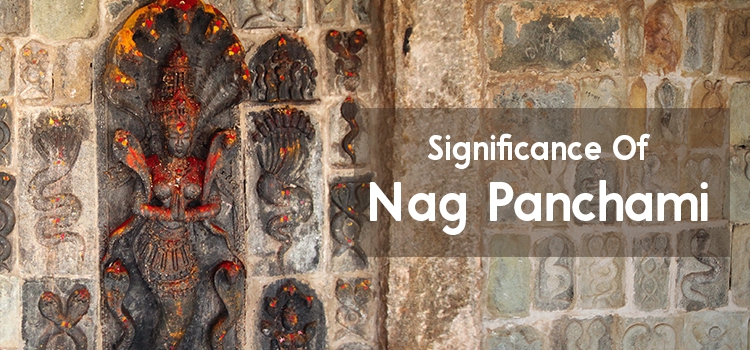Significance Of Naga Panchami
Naga Panchami: The Snake Festival:
Naga Panchami is a Hindu festival that is celebrated in honor of snakes. Many states in India celebrate this festival. It is also an important festival in neighboring Nepal. In 2020, Naga Panchami is on July 25. People worship at snake temples and offer milk and rice to snake gods on this day. if there is a snake pit nearby they will worship it with flowers and pour milk into it. This is believed to please the snakes and help invoke their blessings.
Snake worship in India:
Snakes have always been revered in Indian culture. One reason is that they are associated with several gods in Hindu religion, like Shiva, Vishnu, and Subramanya or Murugan. Secondly, they are associated with the lunar nodes and shadow planets, Rahu and Ketu, in Vedic astrology. These planets are regarded as malefics which can cause many problems in a person’s life. They are depicted as the head (Rahu) and tail (Ketu) of a snake. Hence, people fear them and appease them for removing the adverse effects they are believed to cause. Snake temples are not uncommon in India, a fact that testifies to their sacredness and importance. Some of the famous snake temples in India are:Mannarassala temple (Kerala) Naganathaswamy temple (Tamilnadu),Nagaraja temple (Tamilnadu), Agasanahalli Nagappa temple (Bangalore), Kukke Subramanya temple (Karnataka), Sheshnag temple (Jammu&Kashmir), and Bhujang Naga temple (Gujarat).

The snake gods are called Naga Devatas and it is considered a sin to kill them. in case a snake is killed, a pooja is performed to ward off the snake’s curse on the person who killed it. The curse of a snake is referred to as ‘Sarpa kopam’ or sarpa saapam, where ‘kopam’ means ‘anger’ and ‘saapam’ means ‘curse’.. This is often manifested as delays in marriage, marital problems, lack of progeny, long-standing problems which defy resolution, negative thoughts, troubled relationships, hearing problems, litigation, skin diseases like psoriaisis, intestinal problems, etc. In astrology, these are called Sarpa Dosha, which are caused by malefic placement of Rahu and Ketu. One of the most feared doshas related to serpents in astrology is the Kala Sarpa Dosha, where all the planets in the person’s birth chart are found encircled by Rahu and Ketu. This is seen as a sign that the person suffers from the curse of a snake. Those with Kala Sarpa Dosha often suffers delays, losses, and defeats in life. Happiness and mental peace elude them, and they are often betrayed by relatives and friends. They will face losses in career, business, etc. Astrological remedies for such doshas include fasting and worshipping Naga Devatas on Naga Panchami day.
Ancient Hindu scriptures like ‘Agni Purana', ‘Skanda Purana', ‘Narada Purana' and Mahabharata, contain many stories about Naga Panchami festival.One is the ‘Sarpa Satra’, or snake sacrifice ‘Yagna’ performed by Janamejeya, who was the son of King Parikshit who died of snakebite. The serpent which killed him was Takshak. The purpose of the Yagna was to eliminate all snakes, as revenge against Takshak. According to the myth, a snake became entangled in the Sun God’s chariot and got pulled into the hawankund or sacrificial fireplace. Realizing that this posed a threat to the Sun God, the other gods tried to stop the Yagna.. It was Astika Muni, the son of Goddess Manasa, who eventually convinced Janamejaya to halt the yagna before Takshaka perished in the fire.
Hindu mythology talks about many Serpent Gods, but the following 12 are worshipped even now:
Vasuki, Ananta, Shesha, Padma, Kambala, Karkotaka, Takshaka, Pingala, Kaliya, Ashvatara, Shankhapala, and Dhritarashtra..In Yoga, Prana or Life Force is represented as a coiled serpent lying at the base of our spine. This is called Kundalini. This mystical energy, when awakened, is believed to confer miraculous powers.
Rituals of Naga Panchami
On the day of Nag Panchami, the images or idols of the Naga Devatas are bathed with water and milk, following which some offerings are made. Milk, flowers, and sweets are among the offerings. Women also light lamps to real snakes, believing that their prayers would elicit the blessings of the Serpent Gods. On Naga Panchami, digging the earth is said to be inauspicious, as it could disturb the snakes living underground. The festival is important to farmers, as the risk of succumbing to snake bite is great for farmers who work in the fields. At the same time, snakes help farmers too by killing rodents and protecting their food crops. Hence, in the farming community, snake worship has its own significance.
In many villages, women make a ‘rangoli’ of a five-hooded snake on the floor, with turmeric or sandalwood paste. In front of this, a silver bowl with a lotus flower is kept. Offerings are made to this image after the worship. Women pray for the well-being of their brothers and a happy family life. Images of snakes are also drawn on the walls and doorways outside the house. It is believed that this will ward off poisonous snakes. Shiva is also worshipped on this day, as he is the protector of snakes. People observe fast and feed Brahmins, too, on Naga Panchami.
The Significance of Naga Panchami
Fear. Dread. Hatred. These are the common emotions that the sight of a snake usually evokes in us. But snakes have an important role to play in our ecosystem. Pests like rats and mice cause damage to the tune of millions by destroying food crops. Some carry parasites like ticks that can cause diseases like Lyme’s disease. It was rats that spread the bubonic plague in the century. Using chemicals pollutes the environment with its attendant costs. But snakes provide a free, easy, eco-friendly and natural method of pest control. They attack only when they face a threat. In the monsoons, as water seeps into their hiding places, they come out and enter homes nearby. If they are not handled carefully, they can pose a threat. Interestingly, Naga Panchami is celebrated in the month of Shravan (July-August), when the monsoon season is on. By worshipping the snake deities during Naga Panchami, people invoke their protection from the snakes they may run into during this time. One could also infer that it is also a way of recognizing the importance of snakes in the ecosystem, where every creature has a role to play in maintaining balance and thereby ensuring the survival of all the other creatures who form a part of it.



















